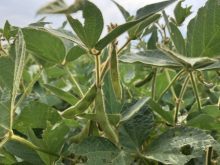Many years ago when I was a veterinary student, I worked at a veterinary laboratory doing post- mortems.
Periodically, an emaciated sheep carcass would be dropped off at the lab. My job was to open it for the pathologist so the cause of death could be determined.
These animals were devoid of all fat reserves. When I cut into their intestines, I saw swarms of minute worms. The vast number of worms had sucked all the energy from the sheep, which had actually starved to death while the worms flourished.
Read Also

Trump’s trade policies take their toll on Canadian producers
U.S. trade policy as dictated by president Donald Trump is hurting Canadian farmers in a multitude of ways.
Though these extreme cases of parasitism are exceptions, they
illustrate that worms can have significant effects in the body. Are intestinal parasites a concern in flocks in Western Canada?
Researchers addressed this question and reported their findings in the Canadian Veterinary Journal.
The most common worms that infest sheep fall into the nematode family. Indeed, it was nematodes that caused the death of the sheep that I saw so many years ago.
Nematodes spread readily between sheep on pasture. Their life cycle is dependent on climatic conditions. They don’t move
between hosts until the weather warms up in the spring, and their numbers rise throughout the grazing season.
To get a handle on worm loads, the researchers analyzed lambs going to slaughter during the early part of the grazing season, from May 15 to
July 31.
They collected entire, intact gastrointestinal tracts of 47 lambs from an abattoir in Innisfail, Alta. They were believed to be representative of most lambs raised under average prairie conditions.
Each gastrointestinal tract was examined for worms and eggs. Three nematode types were found – Trichostrongylus, Nematodirus and Trichuris – which all follow a similar life cycle.
The eggs are shed in the manure of one lamb and are then consumed by the next as it grazes on contaminated forage.
Few worms were found in lambs slaughtered in May and June, but as the summer progressed, worm numbers in the tracts increased.
By July, lambs with worms outnumbered the lambs without worms. Of the 19 lambs tested that month, 16 were worm-infested.
The egg counts in these lambs suggested that the parasites had been acquired in late June. Ewes were the original source. Lambs were either picking up their initial infestations directly from eggs recently expelled by infested ewes, or they were consuming nematode larvae that had successfully overwintered on the pasture. It was not possible to determine which source was more significant.
Worm loads in cattle are difficult to estimate based on fecal egg counts because even cattle with a lot of adult worms do not always have high egg counts in their
manure.
In contrast, this study suggested that at least in lambs of slaughter age, there is a good correlation between worm loads and egg counts. A heavy intestinal infestation is reflected by high fecal egg counts. A simple examination of manure from a lamb for the presence of eggs can give a fair indication of its worm load.
The question remains: do lambs need to be dewormed?
Though it makes sense to deworm lambs that have extremely heavy infestations, is there an economic advantage to deworming lambs that look healthy and only have a few worms? The answer has yet to be determined.
Jeff Grognet is a veterinarian and writer practising in Qualicum Beach, B.C.














